The Dover, Delaware Amish settlement
Delaware may be our first state, but examining a US map today, it’s easy to overlook. The average state in America consists of 63 counties; Delaware, with the fewest of all, has just three.
The “one in the middle”, Kent County, is home to the second largest city and state capital, Dover. Just west of Dover city limits you’ll find Delaware’s only Amish settlement, a community founded nearly a century ago by Amish from a variety of states.
As you might expect for an older settlement, with 9 church districts the Dover Amish community is sizeable. There are roughly 1,200-1,500 Amish living here in around 250-300 households.

DE Amish
But it might not be that way forever. In recent years the community has been losing Amish by the buggy load, as they exit for settlements in other states where land is cheaper and roads less crowded (this Virginia Amish settlement is one example).
Like Amish in settlements such as Lancaster County, Pennsylvania, or the Allen County, Indiana community (adjacent to Fort Wayne), the Dover Amish face permanent pressures from living on the edge of a growing city.
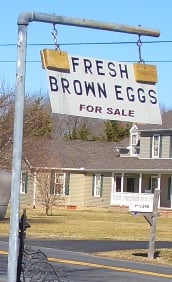
Dover isn’t exactly a huge metropolis, however, with an official population of only about 36,000.
Regardless, Delaware is a densely-populated state, and being right up against the state capital means you’re going to have people wanting to move out of the city and into the more attractive, “quainter” rural areas.
A number of suburban neighborhoods have been constructed in the area, along with a couple of golf courses, including the large Wild Quail residential/golf development. You also have a large number of rural non-Amish natives scattered among the Amish homes.
“Hearse buggies” and playsets
The Dover community was founded in 1915 by Amish coming from many different places. Early settlers arrived in Kent County from Wisconsin, Ohio, North Dakota, Montana, Alabama, Pennsvlvania and other locations.
As noted in the Delaware Amish Directory, “the first eight to ten years were indeed very uncertain for the new settlement, as two of [the first] ten families stayed only a short time”. However enough chose to remain, and by 1928 the church had grown to the point where it was divided into two districts (Delaware Amish Directory 2005, p. 3)
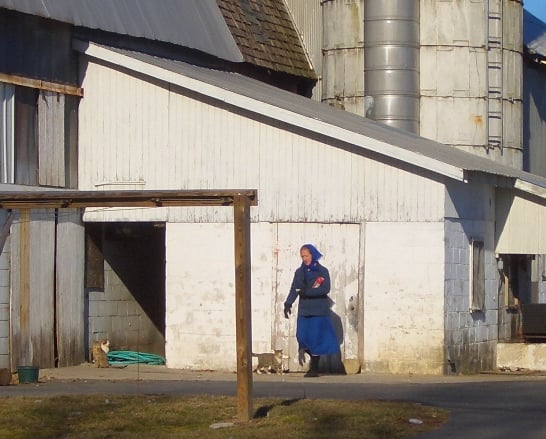
Amish at Dover drive black buggies of a unique style. Characteristic features include bulky size, rounded sides, and a walk-in back door. Some liken the Dover carriage to a hearse due to its unusual appearance. Stephen Scott notes that the open spring wagon is called a “durban” in Dover (see Plain Buggies, p. 68-9).
Dover women wear a prayer covering that is more closely-fitted to the head and with finer pleats than, say the typical Midwest covering. Dover men customarily begin growing a beard after baptism, but before their first communion (see Why Do They Dress That Way?, Stephen Scott, p. 124-5).
Homes here are mostly painted white in traditional Amish style with a few constructed from brick. As is typical for most Amish communities, a range of shops are found throughout the community, as well as some farms.
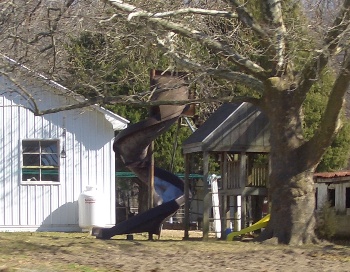
One thing that struck me while on a recent visit: the kids in the Dover settlement make out pretty well. How do I know? You see fairly elaborate children’s playsets everywhere, and one of the schools featured the mightiest set of swings I’ve ever seen in an Amish schoolyard.
Dover Amish roots
On my recent visit, I dropped by a few businesses, including a number of dry goods stores. One of them, Sunny View on Rose Valley School Road, is set up in an old cabinet shop. You can still see the loading deck outside. On my visit to Sunny View I talked a bit with the proprietor, whom I’ll call “Emma”.
Emma and I discussed the fact that many Amish had been leaving the area. In the previous year, she noted that 50 families had left for other Amish communities in 16 different states.
Amish farmland was being purchased for high-end developments, populated by “rich people”–doctors and lawyers, she explained. The farmers who decided to sell their land “helped it along”. At one point, according to Emma, they could nearly name their price; the crash of the economy slowed things down.
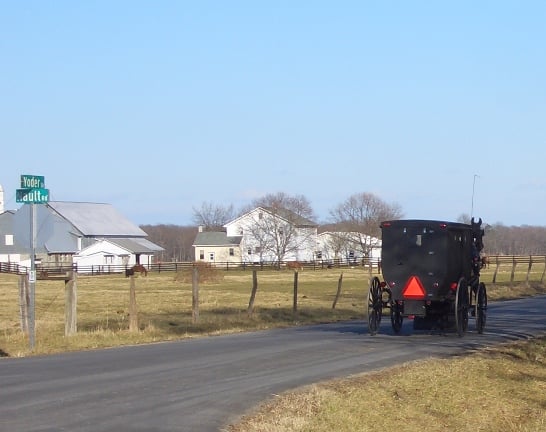
Traveling through the settlement, you do notice a fair share of “For Sale” signs outside Amish homes, as well as formerly Amish homes that have obviously been converted into English residences.
Though Emma was negative about future prospects, she didn’t foresee the extinction of the community. “Do you think the Amish will eventually disappear?” I asked. “No” replied Emma, “though I don’t really know why we stay here.” She continued: “We don’t really have scenery here…a friend came and said all you have here are houses and cars.”
Still, something keeps Emma and others in place: “We have been here a long time so I guess we have roots here.” She noted that it was nearly impossible to build towards the city to the east. Land is easier to get towards the west, and some Amish construct homes there. I did notice a number of new homes while traveling through the community.
Dover Amish church and business directory
While at Sunny View I picked up a Delaware Amish church directory. It was the 2005 edition; apparently a new one should have been out already, but had been delayed. Emma promised to send one to my home address when it came in.

I also picked up a Weaver’s Apparel woolie hat, and asked if Emma knew the proprietor, an Ohio Amish friend of mine. I wasn’t surprised that she did.
Weaver’s is something like my intro when I visit dry goods stores. Most carry Weaver’s products, and it seems about half the people I ask are familiar with Weaver’s owner, a number having met him in person (he has a bug for traveling and visiting his customers’ stores, and let’s just say he’s a memorable guy).
Emma explained that only about 20 families at Dover are still farming full time; the rest rent out their land to English farmers. Dover does have quite a few businesses though. A full listing can be found in the back of the church directory.
This has certainly changed in the interim, but as of 2005, Dover was home to at least 8 cabinet shops, 3 blacksmiths, 3 buggy shops, 11 furniture or woodworking shops (more on Dover Amish furniture), 7 sawmills, 3 greenhouses, 3 post drivers, an appliance store, a quilt shop, a butcher, a number of variety and dry goods stores, a tax service, an auctioneer, a well digger, and one “Windmill Service” (among others).
Delaware Amish no more?
Despite the out-migration in recent times, Dover remains a sizeable Amish community. The Dover community is one of a few Amish settlements within easy striking distance of the East Coast. In fact it is one of the few, if not the only Amish community where a buggy ride to the beach is conceivable (buggyless Pinecraft, Florida doesn’t count!).
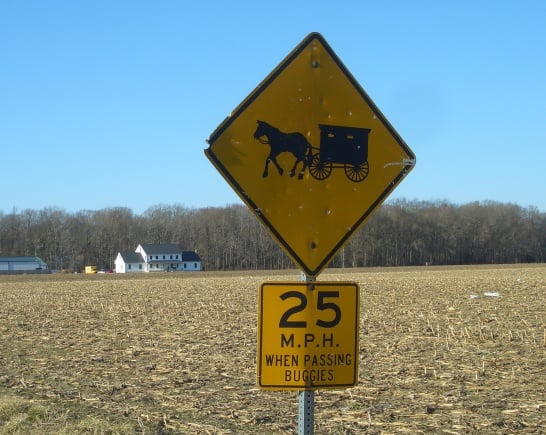
Population pressure won’t disappear though, and Dover Amish may continue to deal with it by entering alternative occupations such as small business and by focusing settlement westwards. Perhaps the community will even begin to spill across the nearby state line into neighboring Maryland.
Communities related to Dover can be found in many places, including at Marion, Kentucky, Leraysville, Pennsylvania, and numerous others (Plain Buggies, p. 69). Barring a drastic change, there will likely continue to be an outflow of families from Dover to these communities as well.


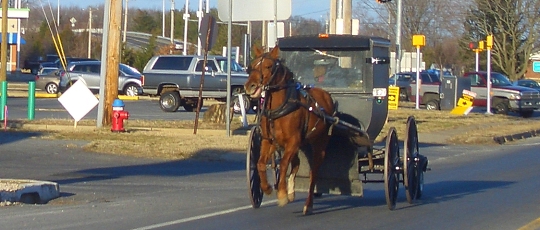
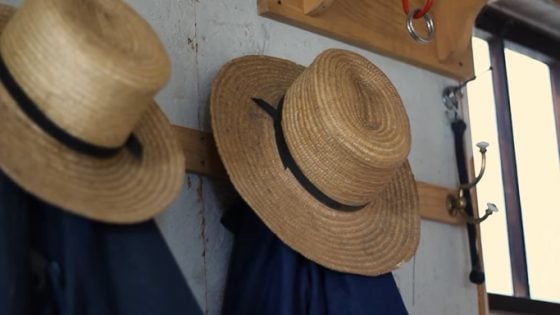
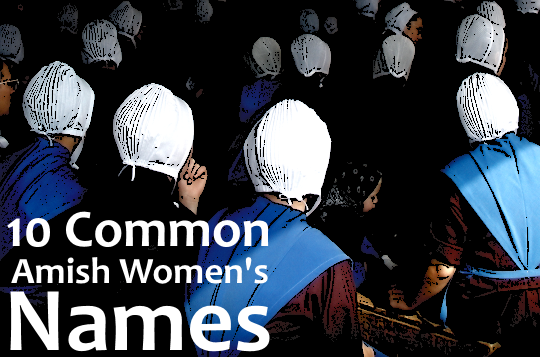

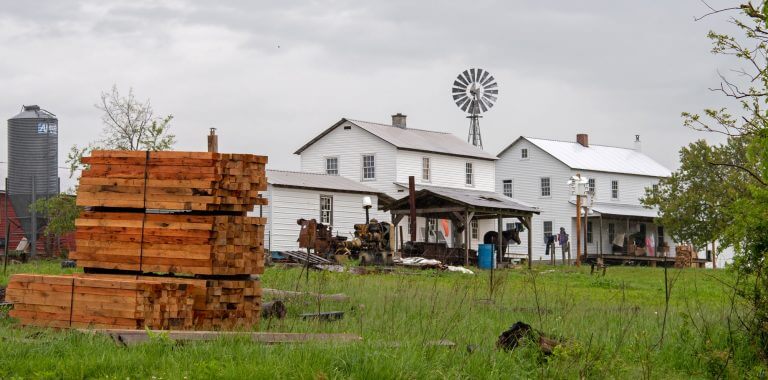

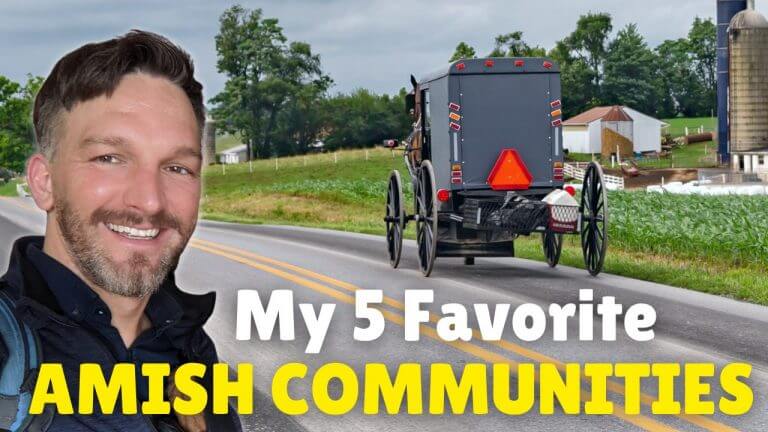
Interesting story Erik and from the sounds of it, this Amish community seems to maybe be on its way out. Maybe the horrible housing market has slowed the buying of land by home builders, and since the land is now worth a little less some Amish maybe holding out to sell. Don’t get me wrong I’m very pro saving farmland, and having a strong farmland saving organization helps in a very big way. So I’m not sure about Delaware’s land savings programs, if they even have anything in place. The state of Pennsylvania does, although that has been effected because of resent budget cuts. Sadly this wont be the first time a Amish community has dissolved, and somehow it becomes a little more sad when it happens right in front of your eyes. Richard. Pennsylvania.
The steadfastness of the Amish in Delaware USA
This community is not on it’s way out. Pennsylvania Amish will be gone before this community of Amish is gone. They are supported and appreciated by all the “English” among them. They are devout and very much true to their word. They are the stablizer for the communities that surround them.
Amish
Here it is 2018 and the Amish are very much apart of our community here in Smyrna and Dover Delaware. Buggies are still trotting along the roads although, I do see some Amish traveling in Ubers or even driving themselves in vehicles on 13. My house backs up to an Amish farm in Kent County, I hope they stay forever.
Delaware Amish population
Richard glad you enjoyed it, I should emphasize here that it is still a sizeable community. My hunch is that there’ll be a Dover Amish community for quite awhile yet, though the departure rate has been pretty rapid for at least the last few years.
When the new directory comes out we’ll get a better sense of how things stand. For this I had to basically estimate the current population; as of 2011 there are 9 districts. In 2005 there were also 9 districts, but they were pretty large on average (37 households each).
It’s a good question about the farmland program. I know PA has been pretty aggressive on that front but have no idea of what Delaware might have in place.
Maybe one of the Delawareans reading this could let us know!
farmland perservations
I am not aware of any preservation of farmland…I do know that there are several wet-lands perservations. I would think that out west of Dover and off Rt9 in the Kent county area that there are some farmlands that are never going away. We thrive off the farmland. I know that NJ has some type of program. I grew up in Dover…
Land preservation
There is a preservation program here It has been very politically motivated If you are selling home made things from your farm, or you are having people pay for a farm related service called Agri tourism you will not be accepted into the program . The reason given by the Sec of ag here in de is they will lose their federal funding for the program. So far no one has been able to receive that federal funding. There have been several attempts to legislate farm land preservation for farms who do participate in agritorisum. These attempts have failed. The average amount of money that has been paid out to preserve a few farms here in de is about $2000 per acre ,a one time pay out. Those farms received state funding not federal In the time of budget crunches I woul say you won’t see any time soon any farms being preserved here in de The developers seem to have the upper hand.
Hi Erik and Richard. I am from Milford, Delaware and raised Mennonite. My mother was raised Amish out in Yoder, KS and moved to Delaware when she was about 12 yrs old, changing over to “conservative” Mennonite.
Delaware does have a “Farm Preservation” program, but I can’t give you all the particulars.
For years I have shopped at Byler’s store that sits at the corner of Route 8 and Rose Valley School Road (west of Dover). It just amazes me how going west of Dover the area has grown/expanded with homes, condos, etc. One certainly can’t blame the Amish for leaving that area. The traffic is unreal. Oh, and don’t forget the ones that moved here because they found the area so “quaint”. They loved seeing the buggies, the farmland and such, only to fuss and complain about the horse “manure” on the roads, even taking it as far as complaining to our local paper “The Delaware State News”. Most of us say, you have seen our “manure”, now go home!!!! lol
Visiting the Delaware Amish
Well put Betsy 🙂 I’ve never gotten the manure complaints by the city transplants. And then to complain in the paper. Mind-numbing.
I did drop in to Byler’s–mostly English shopping there but there was at least one Amish family.
I had only scooted through Delaware once before this trip (I’ll be honest–I was traveling around eastern PA and took a wrong turn that led me in to Wilmington) but I enjoyed my first real visit to the state and to the Amish settlement.
I had always heard of the land pressures for the Dover Amish, but what surprised me most when researching this was that Dover is so small population-wise.
The Allen County IN community I mentioned in the post is right up against Fort Wayne, which is about 7 times larger, but you don’t hear of the same issues.
Of course you do have to take the overall population density into account and the fact that land in the East is going to generally be higher than in the Midwest.
Anyway, great to hear from a native Delawarean, hope we’ll hear more from you Betsy!
My understanding is that the Halifax County, Virginia Amish settlement near Nathalie was founded by folks who left the Dover area. I can understand why they left. My father’s family was originally from the Sussex County Delaware area and I am still amazed at the amount of growth there since I was a child.
Nathalie Va Amish Community
It is true that many of the Amish Families that started the Amish Community here in Nathalie Va.
Coblitz, Miller, Byler,Swartzentruber.
All of these Families are a great addition to our Community. At this point they have 2 Churches, 3 Schools and approx 60 families. They have A Store, Harness shop, drygoods store, sewing and sundry store, furniture store and a shed shop.. there are carpenters, Masons, framers, poll building makers. They are now putting up chicken houses to sell Organic Free Range eggs.
We are blessed to have them as dear friends and Neighbors..
hi Betsy. I’m glad that Delaware has a farm preservation program, and even thought that state is facing the same problems that most states are now coming to gripes with, maybe they can stop or slow the Amish from leaving that state. i think there is a double edge sword when land prices become cheaper because of the economy, its more reasonable for developers to buy it, but the folks selling the land receive less than they should for it. I think one of the best ways to save farmland is through easements. Its worked pretty well in Lancaster county, and even though some farmland is being lost at least they are trying to save as much as they can. And i hope Erik is correct that about the time- table of any Amish leaving, because I’m sure what will be replacing those Amish farms will be housing and commercial developments. Richard from Lebanon’s Amish community.
I spent about an hour driving thru the Dover countryside last week; my 3rd visit. Stopped at Bylers, Shady Lane Selections (Amish-owned variety store), and another Amish craft/scrapbooking/rubber stamp store. I see Bylers has expanded with a new location further south on Rt 13 in Harrington, near the state fairgrounds. The mid October school benefit auction on Yoder Road is worth attending – basically a “mud sale” with maybe 1500-2000 in attendance.
Rick I dropped in to Shady Lane as well, and I bet we were at the same stamp shop (big trampoline out back). As I drove home to NC, I remember passing a Byler’s a good ways out of Dover–maybe that was the one you mean.
I remember that you sent me the first batch of Dover photos a few years back.
Ruber Stamp/Scrapbooking store address??
Any chance you have the address or location of the rubber stamp/scrapbooking store? I frequent the ones in Lancaster County, PA and would love to check the one out in Dover, DE. Thanks!
Thanks so much for the interesting article, Erik!
As always I enjoyed viewing the pictures – Every picture tells a story!
I wish I could go to some Amish places to visit and meet the people. Unfortunately, I am unable to do so.
I have some DVDs about the Amish and some photos of Amish children and barns, love those red barns!
Keep up the good work; I certainly appreciate your time and effort!
Several years ago a young Amish guy was training a couple of my mares to be work horses. I would go down to his place which was about a 3 hour drive from my home and work with him as he used my mares to do his farm work. Often I would stay for several days at the farm of one of my coworkers and this would allow me to work with John for several days at a time. During those days we would literally work together for 6 to 8 hours a day, for multiple days. During those hours working together we would discuss all sorts of things. I was amazed at the understanding that he had of issues that I would have thought he would have known nothing about; such as how diesel fuel is marketed and what affects the price of it, use of futures contracts to hedge the price of it, etc.
Anyway, at one point we started discussing family and he told me that his wife had grown up in Delaware. We talked about several aspects of this before he made this statement: “You know, all of the Amish in Delaware can only live in three counties”. I was quite taken aback, I could not imagine that any here in this country and in this day & age that anyone could be refused to live where they wanted to live. So I said, somewhat childlike; “That’s not fair! How can they do that?” He started smiling and I knew that I had been had. He said: “Well there are ONLY 3 counties in Delaware”. Then he added; “That’s a little Amish joke we like to tell someone that is not one of our people”. He was absolutely beaming when I told him that he got me; hook, line and sinker.
You mentioned that some of those who leave have gone to Virginia. Where else do they go? Some of the previous generations did some long-distance migrations to get to Delaware (from NoDak even!) so I’m curious as to whether there is much long-distance migration away from there.
(And as a former North Dakotan, I’m curious about where in that state they came from.)
Former North Dakota Amish settlements
Spokesrider though there are no North Dakota Amish settlements today, there have been at least 4 in the late 1800s/1st half 1900s.
The first and as far as I know longest-lived was in Pierce and Rolette Counties. It grew to 2 congregations at one point, went extinct in 1948 (this info is taken from David Luthy’s excellent book Settlements that Failed).
From what I can tell this is the community which contributed at least one settler household to the Dover community (listed as David H. Yoder in the Dover directory; there is a David Yoder listed at Pierce/Rolette in Luthy’s records).
As to where Dover exports go, there are a couple of communities in the last paragraph that are Dover-related (in KY and PA) and there are others, including in NY, MI, OH, KY (Steve Scott has a bit on this in Plain Buggies) but I’d have to confirm those to be sure on exact locations. I am curious as well b/c as I was informed it is quite a few different places. Not sure how far west they would go.
Oldkat, great story, it rings a bell 🙂
Heard another one while in PA: Did you know that Amish don’t have to pay to get on the PA turnpike?
That’s right, but they have to pay to get off 😉 (money collected on exiting… har har)
I don’t know if this is the reason they left, but I suspect that by the late 1940s Pierce and Rolett Counties, along with much of the Dakotas, had grown more inhospitable to non-mechanized, large-scale agriculture than many other agricultural regions.
It’s interesting how the people leaving the Dover settlements are scattering in so many directions. I had always thought of Amish emigrations as a communal activity — maybe not quite like the Hutterite system — but that groups of families would go off to form a new settlement. Each family going its own way seems a bit individualistic for the Amish, but maybe it’s different when they join existing settlements elsewhere.
Delaware Amish
We live in Delaware and have an Amish farmer; we really appreciate the products that we purchase from him and his family. I would like to know if there is a way that I can learn where the different farms, grennhouses and other Amish owned shop are located in order to purchase goods and/or services directly from them. We occasionally shop at Bylers and make purchases at the greenhouse near Bylers. We welcome and appreciate any information that you can provide. Thank you in advance!
picture question
May I use the to photo to accent a blog post I’m doing? It’s a fantastic shot!
Amish in de
To the question about land preservation in de We farm in new castle co de. We wanted to put our farm in the farm land preservation and were told we can’t because we do what is called agritorusum. The Sec of ag said the state would loose their federal funding if they put us in that program. They buy your development rights and you receive about $2000 per acre You can still sell your farm but the rights still remain on that farm and can’t be sold for development We have made several attempts through legislation to change this to no avail The developers seem to have the upper hand Our farm is surrounded by development here in new castle co and traffic is horrific and machinery must be moved at night I can’t imagine a horse and buggy trying to navigate here Our new neighbors aren’t very tolerable if you have a slow moving vehicle to say the least
I think there is still plenty of room for the Amish in Delaware, especially Sussex and Kent. Even parts of Southern New Castle County. A lot of the farmland is being eaten away near Dover, Symarna, and especially near Middletown. All three are growing and developing towns with lots of farmland on the outskirts and backroads.
I drove through Amish areas today, and the extent of the current community stretches from western Dover near Dover HS to east of Hartly, DE. However, both east and west of Hartly is still plenty of farmland. The roads in the Amish community are nowhere near as congested as Lancaster. The Lancaster community is probably more endangered than the Dover community. The farmland around Dover and other areas is very profitable and unlikely to entirely be purchased by developers.